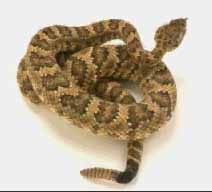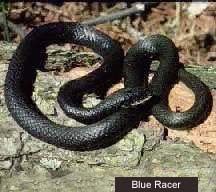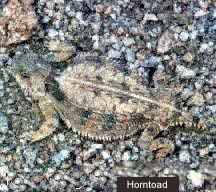

Page 3


RATTLESNAKE
The western diamond-back is recognized by a loose, horny rattle at the end of the tail, which is shaken vigorously to warn off intruders. The rattle is formed when the snake's skin is shed; the end section, or button, of the rattle and an attached ring of the old skin are retained after molting. A new ring is added each time the snake molts, which may be as often as four times a year. The last ring on the rattle often becomes worn and breaks off, so that the number of rattles is not, as popularly believed, an accurate indication of age. It has deep, heat-sensitive pits on the sides of the face, which help in hunting warm-blooded prey. Two venom glands, one in each cheek, are connected by ducts to the base of two long, hollow fangs that retract when not in use. The venom depresses the action of the heart and lungs and damages blood vessels and other tissue. It feed on small mammals and reptiles. It give birth to young from eggs hatched inside the mother. The horned rattlesnake, found in the deserts of the Southwest, is commonly known as the sidewinder.

Racer, common name for several species of snakes noted for their speed and agility. They are found throughout the world, except Australia. Racers are long and slender, with a distinct head and large eyes with round pupils. Their average length is about 1.2 m (about 4 ft.). Some species have a gland that releases venom onto grooved rear teeth, but most are harmless to humans. They feed on small mammals, frogs, lizards, and insects. In temperate zones they hibernate in winter. The blue racer, which is bluish-green above and yellow beneath, is common west of the Mississippi River.

Horned Toad
They are called “horned” for the hornlike spines on the head and back and “toad” for their rounded, toad-like shape. Found in desert regions of the western United States and Mexico, they shuffle into sand or soil to avoid temperature extremes; most feed on ants. Their wide, flat bodies are about 8 to 13 cm (about 3 to 5 in.) long. They are commonly caught and raced by children at western celebrations and often kept as a pet.

Golden Eagle
The golden eagle is most common in the mountainous areas of the western United States and Canada. Females attain a length of about 1 m (about 3 ft.) from the tip of the beak to the tip of the tail, and have a wingspread of about 2 m (about 7 ft.). Males are smaller, as is true for most of the birds of prey. A characteristic of the genus is the feathering of the legs down to the toes. The body plumage is dark brown, with a distinct golden wash over the back of the head and neck, giving the species its name. The tail of adults is brown with several indistinct pale bands; that of immature birds is white with a dark brown terminal band. Most nests are placed on cliff ledges, but in some areas large trees are preferred. The nest is large and coarse, built of sticks and twigs. The same nest is used from year to year, and the birds add more sticks, so that the nest may eventually be as much as 1.8 m (6 ft.) in diameter and 1.5 m (5 ft.) high. The usual number of eggs is two, often only one, and occasionally three. They are heavily marked with blotches and spots of various shades of brown. The diet consists mainly of mammals, ranging in size from mice to deer. Birds are taken most often in the breeding season to provide tender food for the young. If live food is in short supply, golden eagles will eat carrion.
If you enjoyed visiting some of the critters
from my part of the country, click the animated cat below.


 PAGE 1
PAGE 1